The Onset of Dental Erosion Caused by Food and Drinks and the Preventive Effect of Alkaline Ionized Water
Abstract
:1. Dental Caries and Acid Erosion
2. Alkaline Ionized Water
3. Measuring Enamel Surface pH
4. Es pH after Ingesting Acid Beverages and AIW
5. Discussion
6. Conclusions
Author Contributions
Funding
Conflicts of Interest
References
- Michael, W.J.D.; James, S.W. The developing caries lesion. In Primary Preventive Dentistry, 4th ed.; APPLETON & LANGE: Stamford, CT, USA, 1995; pp. 39–60. [Google Scholar]
- Tuominen, M.; Tuominen, R.; Ranta, H. Association between acid fumes in the work environment and dental erosion. Scand. J. Work Environ. Health 1989, 15, 335–338. [Google Scholar] [CrossRef] [PubMed]
- Kitasako, Y.; Sasaki, Y.; Takagaki, T.; Sadr, A.; Tagami, J. Age-specific prevalence of erosive tooth wear by acidic diet and gastroesophageal reflux in Japan. J. Dent. 2015, 43, 418–423. [Google Scholar] [CrossRef] [PubMed]
- Mizukami, S.; Sato, T. Study on the correlation between changes in enamel surface pH before and after soft drink ingestion on saliva flow volume, pH, and buffer capacity. J. Nippon Dent. Univ. College Tokyo 2015, 6, 113–119, (English Abstract). [Google Scholar]
- Ericsson, Y. Enamel-apatite solubility. Investigations into the calcium phosphate equilibrium between enamel and saliva and its to dental caries. Acta Odontol Scand. 1949, 8 (Suppl. 3), 1–139. [Google Scholar]
- Ericsson, Y.; Oberg, H. A nomogram for the determination of saliva. Acta Odontol. Scand. 1952, 10, 67–70. [Google Scholar] [CrossRef] [PubMed]
- Anderson, P.; Hector, M.P.; Rampersad, M.A. Critical pH in arresting and stimulated whole saliva in groups of children and adults. Int. J. Paediatr. Dent. 2001, 11, 266–273. [Google Scholar] [CrossRef] [PubMed]
- Dawes, C. Why is the critical pH and why dose a tooth dissolve in acids? J. Can. Dent. Assoc. 2003, 69, 722–724. [Google Scholar] [PubMed]
- Tanaka, Y. Structure and function of alkaline ionized water apparatus. J. Funct. Water 2017, 12, 29–34, (English Abstract). [Google Scholar]
- Tashiro, H.; Kitabora, T.; Fujiyama, Y.; Bammba, T. Clinical evaluation of alkaline-ionized water for chronic diarrhea: Placebo-controlled double-blind study. Dig. Absorpt. 2001, 23, 52–56, (English Abstract). [Google Scholar]
- Sato, T.; Suzuki, M.; Inaba, D.; Sakurai, S. Usefulness of alkaline ionized water to oral health: Investigation of the effect of AIW on remineralization of enamel lesion and on cariogenic bacteria. J. Funct. Water 2017, 13, 28–29, (English Abstract). [Google Scholar]
- Kichuel, K.P.; David, W.B. Caries activity testing. In Primary Preventive Dentistry, 4th ed.; APPLETON & LANGE: Stamford, CT, USA, 1995; pp. 302–305. [Google Scholar]
- Drizen, S.; Mann, A.W.; Cline, J.K.; Spies, T.D. The buffer capacity of saliva as a measure of dental caries activity. J. Dent. Res. 1946, 25, 213. [Google Scholar] [CrossRef]
- Sellman, S. The buffer value of saliva and its relation to dental caries. Acta Odontol. Scand. 1950, 8, 244. [Google Scholar] [CrossRef] [PubMed]
- Helm, J.F.; Dodds, W.J.; Hogan, W.J.; Soergel, K.H.; Egide, M.S.; Wood, C. Acid neutralizing capacity of human saliva. Gastroenterology 1981, 83, 69. [Google Scholar] [CrossRef]
- Sato, T.; Suzuki, M.; Kamoi, H. Evaluation of dental caries risk by measuring the pH of the enamel surface. J. Jpn. Acad. Oral Human Dock 2016, 11, 14–20, (English Abstract). [Google Scholar]
- Suzuki, M.; Sato, T.; Kamoi, H.; Oshima, Y.; Kumazawa, Y. Basic study on the prevention of tooth ersion due to acidic beverages using alkaline ionized water. J. Jpn. Acad. Oral Human Dock 2017, 12, 26–30, (English Abstract). [Google Scholar]
- Sato, T.; Suzuki, M.; Koike, M. Application of alkaline ionized water to oral care. J. Funct. Water 2015, 11, 45–46, (English Abstract). [Google Scholar]
- Sato, T.; Suzuki, M. Study of the usefulness of alkaline ionized water for oral health. Part I Ultramorphological study on Porphyromonas gingivalis exposed to alkaline ionized water. J. Jpn. Soc. Oral Health Sci. 2018, 9, 26–31, (English Abstract). [Google Scholar]
- Kiuchi, M.; Tanaka, Y.; Higashimura, Y.; Baba, Y.; Naito, Y.; Koyama, K. Effects of alkaline electrolyzed water on intestinal environment and stool characteristics in human. In Proceedings of the 18th Annual Meeting of JSFW Program and Abstracts, Osaka, Japan, 19 May 2019; Volume 54. (English Abstract). [Google Scholar]
- Hayakawa, T.; Kato, N.; Fukuyama, H.; Eto, S.; Inagaki, M.; Nakamura, K.; Suzuki, T.; Shimada, M.; Nakagawa, T. Involvement of nickel in diet in the in vivo anti-oxidative effect of alkaline-electrolyzed water and hydrogenated water, and effect of these test waters on intestinal microbiota. In Proceedings of the 18th Annual Meeting of JSFW Program and Abstracts, Osaka, Japan, 19 May 2019; Volume 55. (English Abstract). [Google Scholar]
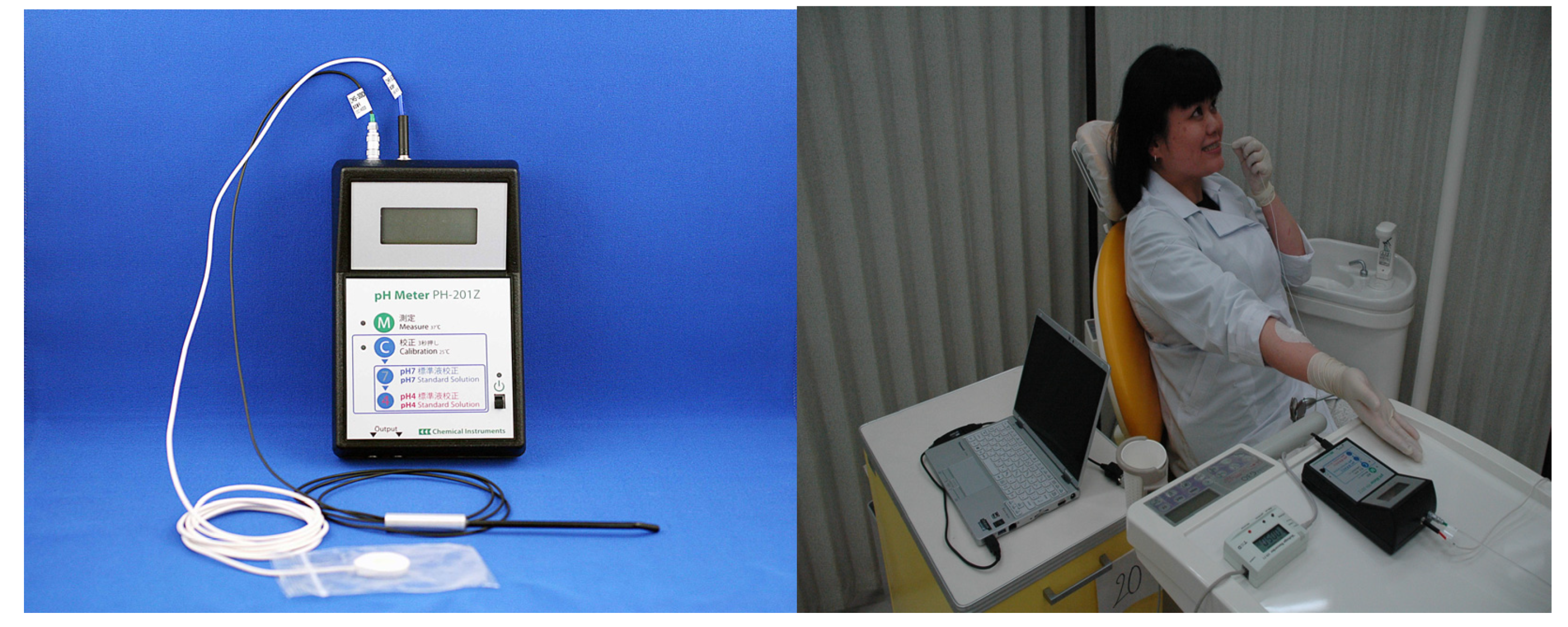
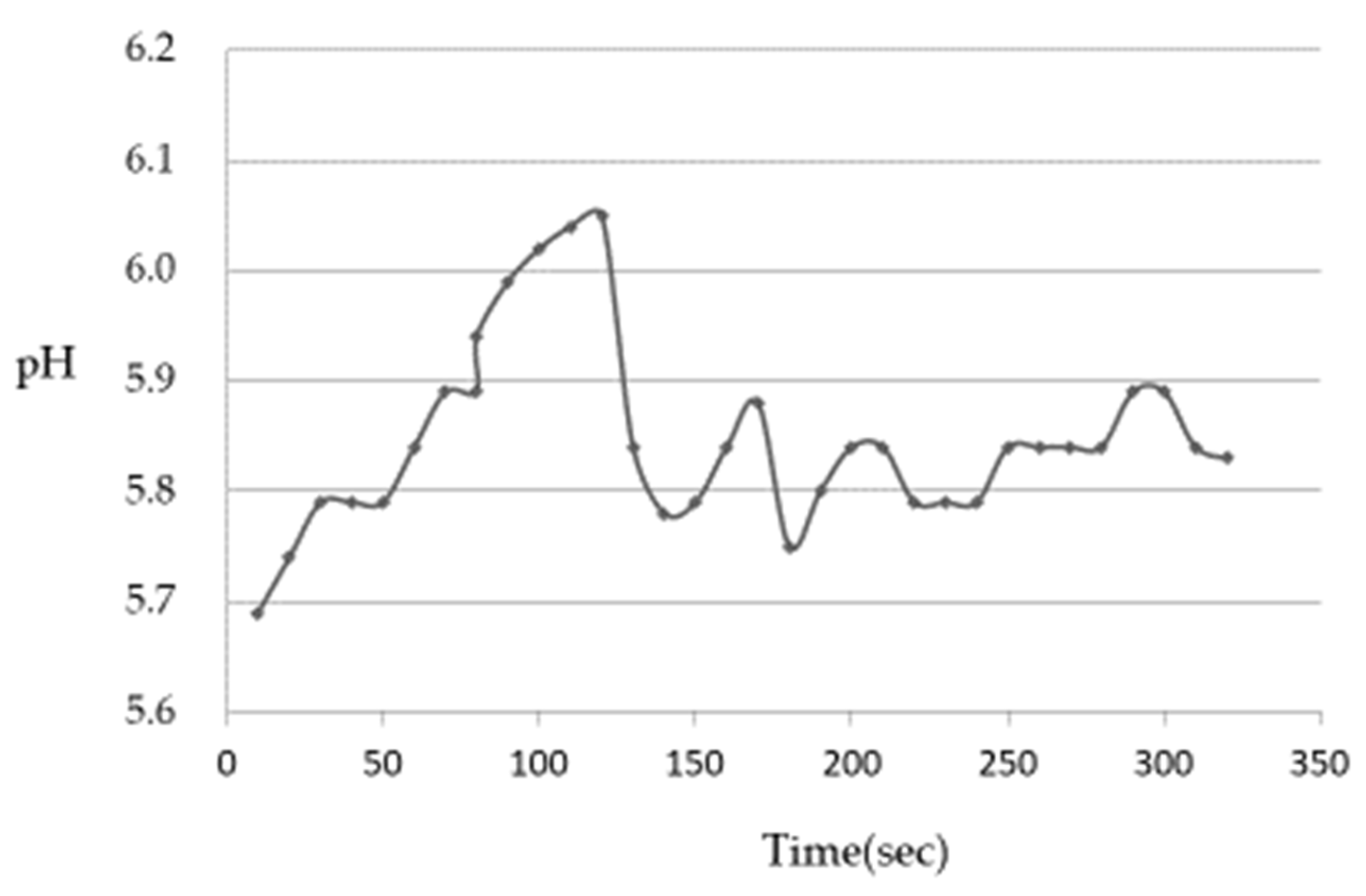
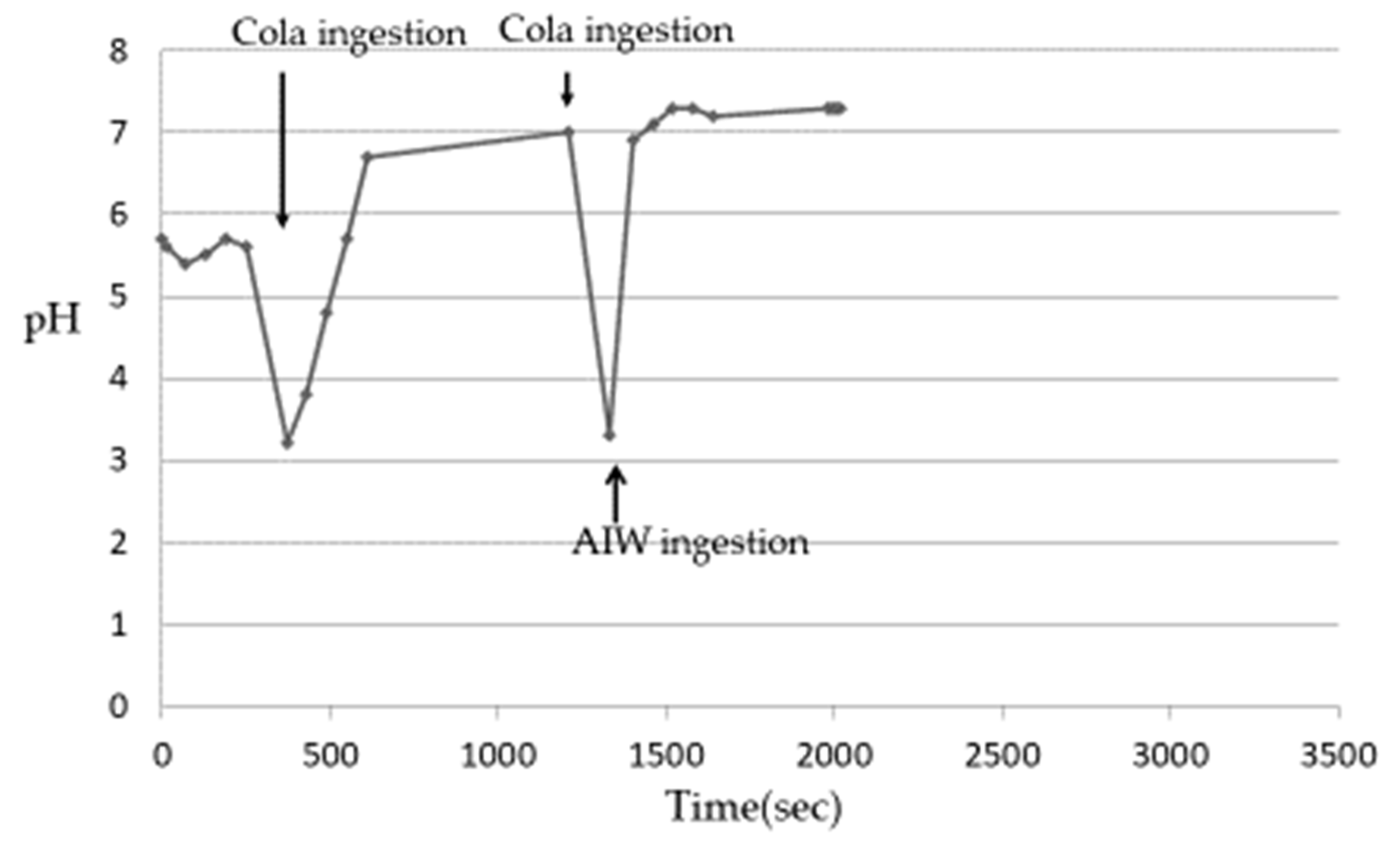
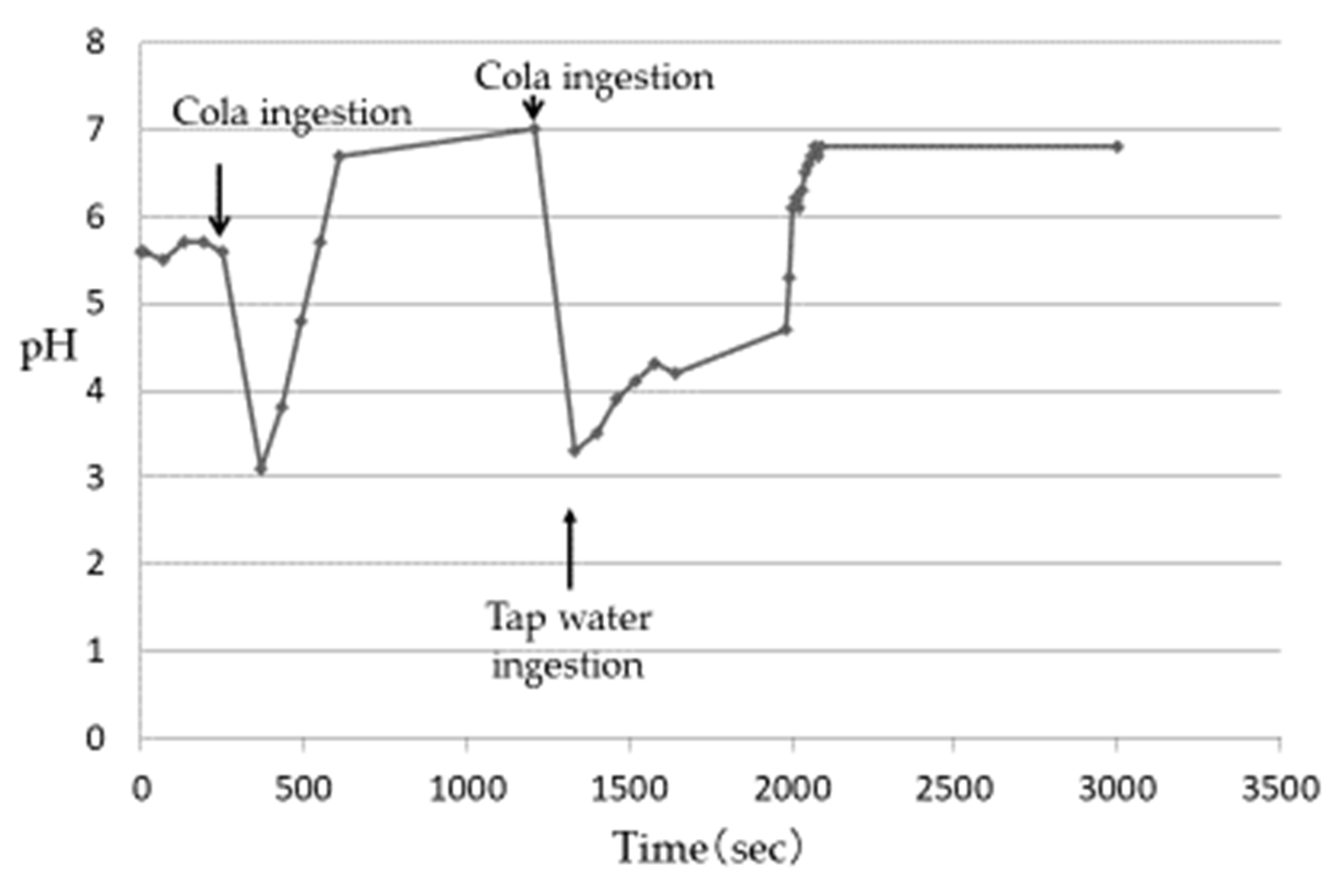

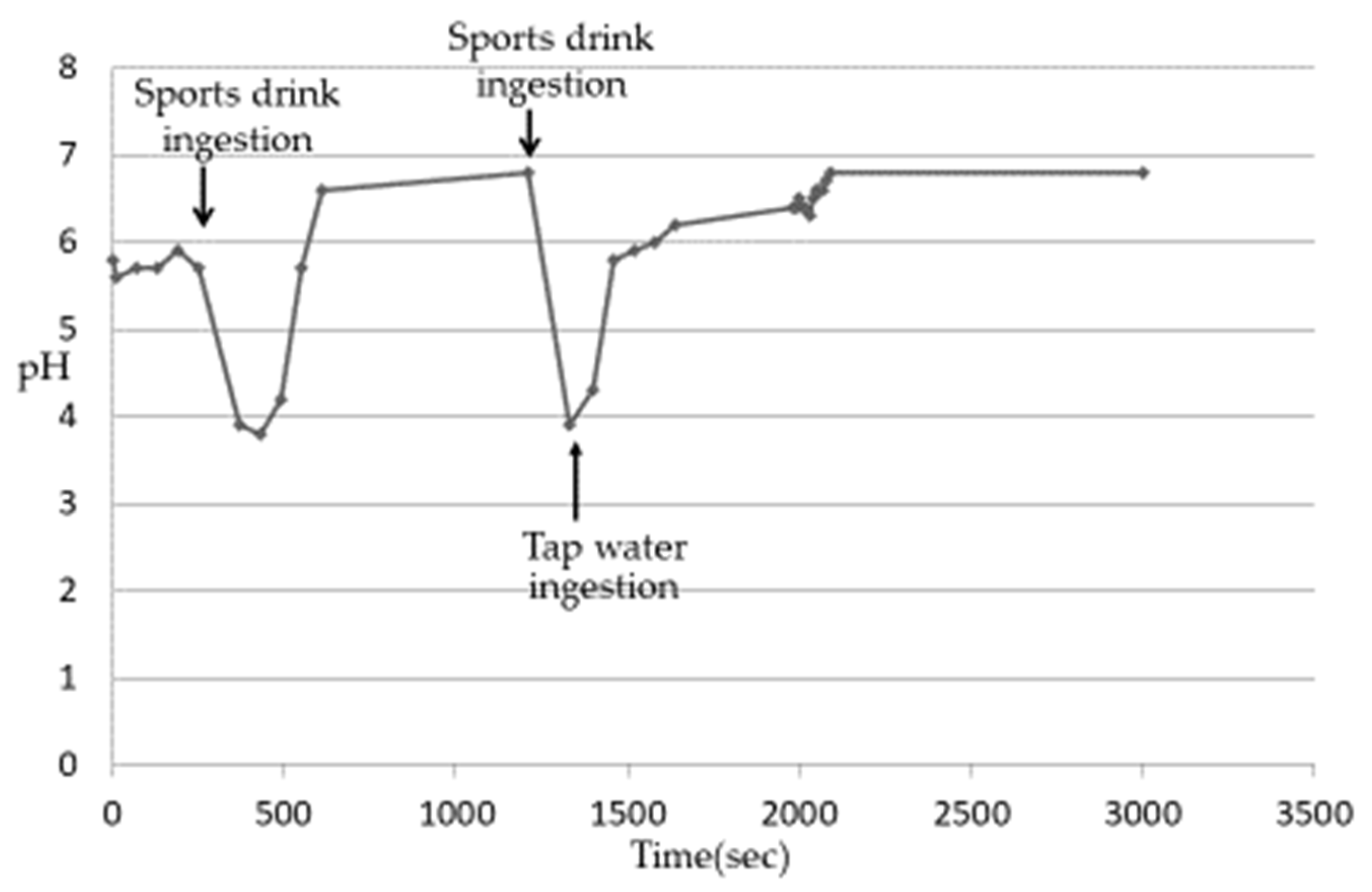
| Beverage | pH |
|---|---|
| Cola | 2.2 |
| Sports drink | 3.3 |
| Orange juice | 3.7 |
| Yoghurt drink | 3.9 |
| Barley tea (Japanese mugi cha) | 6.1 |
| Subject ID | pH (Median) |
|---|---|
| 1 | 5.5 |
| 2 | 5.2 |
| 3 | 5.8 |
| 4 | 5.7 |
| 5 | 5.9 |
| Subject ID | Cola | Sports Drink |
|---|---|---|
| 1 | 3.1 | 3.9 |
| 2 | 3.1 | 3.6 |
| 3 | 3.2 | 3.5 |
| 4 | 3.1 | 3.6 |
| 5 | 3.3 | 3.8 |
Publisher’s Note: MDPI stays neutral with regard to jurisdictional claims in published maps and institutional affiliations. |
© 2021 by the authors. Licensee MDPI, Basel, Switzerland. This article is an open access article distributed under the terms and conditions of the Creative Commons Attribution (CC BY) license (https://creativecommons.org/licenses/by/4.0/).
Share and Cite
Sato, T.; Fukuzawa, Y.; Kawakami, S.; Suzuki, M.; Tanaka, Y.; Terayama, H.; Sakabe, K. The Onset of Dental Erosion Caused by Food and Drinks and the Preventive Effect of Alkaline Ionized Water. Nutrients 2021, 13, 3440. https://doi.org/10.3390/nu13103440
Sato T, Fukuzawa Y, Kawakami S, Suzuki M, Tanaka Y, Terayama H, Sakabe K. The Onset of Dental Erosion Caused by Food and Drinks and the Preventive Effect of Alkaline Ionized Water. Nutrients. 2021; 13(10):3440. https://doi.org/10.3390/nu13103440
Chicago/Turabian StyleSato, Tsutomu, Yoshitaka Fukuzawa, Satoshi Kawakami, Megumi Suzuki, Yoshinori Tanaka, Hayato Terayama, and Kou Sakabe. 2021. "The Onset of Dental Erosion Caused by Food and Drinks and the Preventive Effect of Alkaline Ionized Water" Nutrients 13, no. 10: 3440. https://doi.org/10.3390/nu13103440
APA StyleSato, T., Fukuzawa, Y., Kawakami, S., Suzuki, M., Tanaka, Y., Terayama, H., & Sakabe, K. (2021). The Onset of Dental Erosion Caused by Food and Drinks and the Preventive Effect of Alkaline Ionized Water. Nutrients, 13(10), 3440. https://doi.org/10.3390/nu13103440






